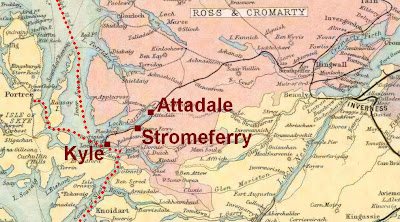Picking up the story from Part 2, many and vocal had been the pledges in support of the proposed railway from Dingwall to the west coast at Kyle of Lochalsh but when it came to calling in these pledges in 1865, the actual cash was a bit slower being forthcoming. Also, one of the landowners along the route, Sir William MacKenzie of Coul (near Contin), refused to allow the railway to pass through his estate necessitating expensive deviations from the planned route.
On way or another, the directors had to cut their cloth somewhat and soon realised they couldn't afford to build the railway all the way to Kyle. Instead the terminus would have to be at Attadale near the head of Loch Carron. Although Attadale was the nearest point on the west coast, it was about 16 miles from the shipping lanes to the south from Portree on Skye and Stornoway in the Outer Hebrides: it was this trade (especially cargo - fish and livestock from the islands) which the railway was banking on intercepting and Kyle would have been a much better place to siphon it off at than Attadale.
Despite this disappointment, work on the railway began in September 1868 but as a result of persuasion by director Sir John Fowler - the railway engineer who would later become responsible for the Forth Bridge - it was soon decided to extend it further down Loch Carron to Stromeferry. The railway was opened to passengers on 19th August 1870. The picture below shows the terminus at Stromeferry viewed from the north side of Loch Carron. From left to right on the far side of the loch are the engine shed, station and pier (wuith steamer alongside), the stationmaster's house, railwaymen's cottages and the hotel. The white building in the foreground is the inn at North Strome on the north side of the ferry across the loch.
The Dingwall & Skye Railway Company (DSR) which had built the line would not operate the trains over it, however. These would be run by the Highland Railway Company (HR) which owned most of the other lines radiating from Inverness under a deal whereby the HR paid the DSR 2 shillings (10p) per train-mile over the line to Stromeferry for up to two runs each way per day and 1 shilling and 10 pence (about 9p) per train-mile for additional runs. From this would be deducted £200 per year for the DSR's use of the HR's station at Dingwall.
Another concern to the DSR was steamer connections. The whole point of the line, really, was to capture traffic to the islands of Skye and the Outer Hebrides beyond the terminus of the railway but, perhaps not surprisingly, the principal shipping company in the north west, David Hutcheson & Co (the forerunner to MacBrayne's), declined to divert their steamers to Stromeferry. Hence the DSR was obliged to buy two steamers of their own, the Oscar and the Jura, to sail respectively to Portree (daily ex. Sunday) and Stornoway (twice a week).

The pier with the station on the left. The inn at North Strome visible on the right
The initial timetable was two return trains a day between Inverness and Stromeferry. The down trains (from Inverness) departed at 9.15am and 3.10pm and arrived at Stromeferry at 1.15pm and 7.15pm respectively. The steamers sailed in connection with the morning train arriving at Portree (via Kyleakin and Broadford) at 8.00pm and Stornoway at 10.00pm. The single fare between Inverness and Stromeferry was 4 shillings and 5 pence (22p) or 8 shillings and 10 pence (44p) First Class. This was considerably cheaper than the 6 shilling fare on the mail coach as well as being infinitely quicker and more comfortable.
The following year, 1881, MacBrayne's took over the mail run from Stornoway to Ullapool (which involved passengers making a 5 hour coach journey to connect with the evening train to Inverness at Garve) but in 1885 the mainland terminus of that service moved to Stromeferry as well.
The late 1880s, then, were the high water mark of Stromeferry's fortunes as a railway terminus, the only one on the west coast of Scotland north of Oban (to where a railway had opened in 1880). By now, there were three trains a day and daily steamers to Portree and Stornoway connecting with the noon train from Inverness. But it would be all change for Stromeferry in the 1890s as proposals for more railways to the north west were tabled.
To be continued ...











